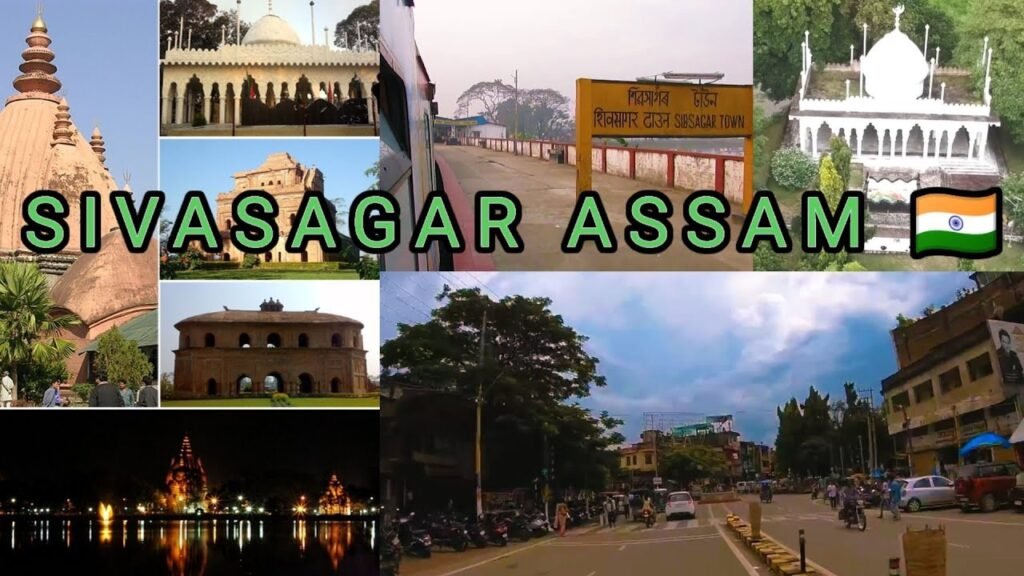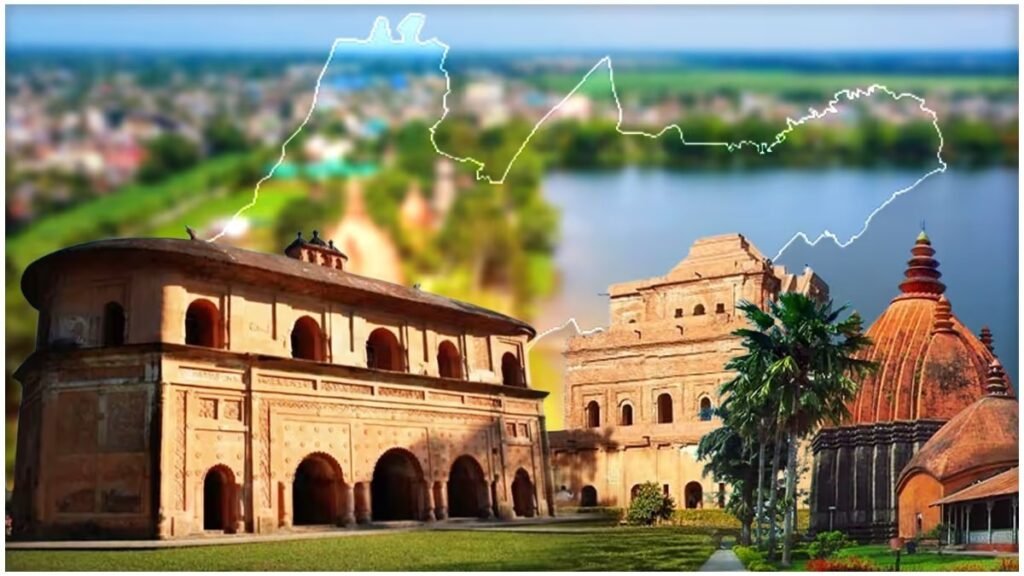Sivasagar, nestled in the heart of Assam, is a living museum of India’s northeast, revered for its regal Ahom past, cultural vibrancy, and spectacular monuments. Once the thriving capital of the mighty Ahom Kingdom, Sivasagar lures travellers, history buffs, and spiritual seekers alike with its fusion of history, natural wonders, and a welcoming community that treasures its legacy.
Sivasagar, meaning “Ocean of Shiva,” was once known as Rangpur. Its origin story is inseparable from the Ahom dynasty, whose rule transformed Assam for nearly six centuries. Today, it stands as a testimony to architectural genius, cultural inclusivity, and ecological balance, blending spiritual landmarks with serene lakes and thriving industries.
Location: Geography and Map
Sivasagar lies in Upper Assam, surrounded by lush rainforests and intersected by the Lohit and Dihing rivers. Its strategic location allowed it to control the region’s trade, agriculture, and waterways, shaping its status as a seat of power for centuries.
The district covers an area of approximately 2,668 square kilometres and boasts a rich biodiversity, including rivers and fertile plains that are ideally suited for agriculture and eco-tourism.
Route: How to Get There
Travelling to Sivasagar is remarkably convenient, whether by air, rail, or road:
- By Air: Jorhat Airport (75 km) and Dibrugarh Airport (95 km) are the closest options, offering direct flights from Kolkata, Guwahati, and New Delhi.
- By Train: Simaluguri Junction and Sibsagar Town station connect the city to India’s major metros via regular trains.
- By Road: National Highway 37 links Sivasagar with Guwahati, Jorhat, and other regional hubs. Buses, taxis, and private vehicles are commonly used for last-mile connectivity.
- The city lies about 360 km from Guwahati, and suggested road routes often recommend stopovers at Kolkata, Guwahati, or Patna for longer-distance travellers.
Key Details:
Accommodation Costs:
Travel Costs (2025):
- Flight to Jorhat (the closest airport) from Delhi: approximately ₹4600 one-way; Dibrugarh is also an option for a similar cost.
- Taxi from Jorhat/Dibrugarh to Sivasagar: ~₹850–₹900.
- Intercity buses (Guwahati–Sivasagar): ~₹500.
- Local transport: Cycle rickshaws and autos are widely available, with fares ranging from ₹30 to ₹100 for short trips.
- Full sightseeing taxi/day: ~₹1200–₹1600.
Best Visiting Months:
- Avoid July–September (monsoon) due to heavy rainfall and accessibility issues.
- October to March: Pleasant weather, major festivals, and ideal sightseeing.
Historical Grandeur
Its history is inextricably linked to the Ahom dynasty, which ruled Assam from 1228 to 1826. As their capital from 1699 to 1788, Sivasagar witnessed the zenith of Ahom administration, resistance to invasions (notably by the Mughals), and an explosion of artistic and architectural prowess in the region.
- Rang Ghar (the royal sports pavilion), Talatal Ghar (an underground palace), and the series of majestic tanks bear silent witness to its past glory.
- The Ahom rulers also laid the foundation for Assam’s unique script, traditions, and multi-ethnic harmony, making the region a melting pot for generations.
Cultural Tapestry: A Blend Like No Other
Multiple ethnic groups, including the Mishing, Naga, and indigenous Assamese communities, enliven Sivasagar’s streets with diverse languages, costumes, and vibrant festivals. The city’s culture is reflected in:
- Annual religious celebrations, most notably those at the Shivadol temple complex.
- The preservation and practice of classical Assamese music, Bihu dance, and folk rituals.
- Local crafts, including textiles and pottery, were passed down through generations.
The living traditions of Sivasagar serve as a poignant reminder of how the Ahom dynasty seamlessly integrated indigenous and Indo-Aryan influences, leaving a cultural legacy that endures to this day.
Must-Visit Tourist Spots
Sivasagar is dotted with unparalleled heritage sites and nature escapes, making it one of Assam’s premier tourist destinations.
- Shivadol Temple Complex: Three iconic temples (Shiva Dol, Vishnu Dol, and Devi Dol) rise elegantly by the Sivasagar Tank. The main Shivadol, built in the 18th century, is the region’s spiritual heart.
- Rang Ghar: Asia’s oldest surviving amphitheatre, once echoed with royal sports and games.
- Talatal Ghar & Kareng Ghar: Marvels of military architecture, famous for their secret tunnels, underground passages, and regal chambers.
- Joysagar & Gaurisagar Tanks: Grand Ahom-era tanks ringed with ornate temples and teeming with migratory birds and lotuses.
- Pani Dihing Wildlife Sanctuary: A paradise for bird-watchers and photographers, sprawling across wetlands and home to exotic migratory species.
- Ahom Museum: Dive into the region’s royal past with displays of armour, manuscripts, jewellery, and coins from the golden age of Assam.
- Charaideo Maidams: Located nearby, these “Assamese Pyramids” are the ancient burial mounds of Ahom royalty, often compared to those in Egypt.

Economy and Revenue
While ancient Sivasagar flourished on military and administrative might, modern Sivasagar’s economy is underpinned by agriculture, oil, and tea.
- Agriculture remains the backbone, with rice, pulses, and seasonal vegetables as major produce.
- The region’s soil and weather have made tea cultivation a mainstay, supported by a robust network of public and private tea estates.
- Oil exploration is spearheaded by industry giants like ONGC and Oil India Limited, whose recent investments are reshaping the district’s infrastructure and employment landscape.
Sivasagar recorded a Gross Domestic Product (GDP) of approximately Rs. 16,02,835 lakhs (2018-19). Key investments in solar projects and industrial development continue to drive up revenue and per capita income.
Education and Literacy
The literacy rate in Sivasagar stands at an impressive 80.41% (2011 census), supported by a range of educational institutions, including Sibsagar Girls College and Sibsagar College, among others. The gender ratio amongst the literates reflects ongoing improvement in female education.
Major Festivals and Events
- Maha Shivratri: A grand annual celebration at Shivadol.
- Bihu: Assam’s most beloved harvest festival, celebrated with traditional music, dance, and community feasts.
- Magh Bihu and Durga Puja: Cultural symbols of unity and devotion for Sivasagar’s multi-ethnic population.
Recent News: 2025 Update
ONGC, in collaboration with international experts, is actively combating the gas leak crisis at the Rudrasagar Field in Sivasagar, Assam. The state government has also extended the Armed Forces (Special Powers) Act (AFSPA) in the district until March 2026 amid ongoing relief and development initiatives, reaffirming Sivasagar’s strategic and economic significance in the region.
FAQs About Sivasagar
Why Is Sivasagar Famous?
Sivasagar is renowned for being the historic capital of the Ahom dynasty, boasting unique tanks, grand temples, and architectural marvels such as Rang Ghar and Talatal Ghar.
What Are the Top Tourist Attractions?
Top spots include the Shivadol, Rang Ghar, Talatal Ghar, Joysagar Tank, Gaurisagar, and Pani Dihing Wildlife Sanctuary.
How Can One Reach Sivasagar?
Sivasagar can be reached by flights to Jorhat or Dibrugarh airports, by trains to Simaluguri Junction or Sibsagar Town, or by road from major Assam cities.
What Drives the Economy of Sivasagar?
The economy is primarily fueled by agriculture, oil (produced by ONGC and Oil India Limited), and tea gardens. Recent industrial and solar power initiatives contribute to growth and employment.
What Is Special About Sivasagar’s Culture?
Sivasagar’s culture is a harmonious blend of Assamese, Ahom, and various ethnic influences, seen in its temples, festivals, music, and crafts.
What Recent Developments Have Taken Place?
ONGC’s ongoing oil projects and the recent extension of AFSPA highlight Sivasagar’s strategic and economic prominence in Assam. Large-scale relief efforts during floods and the sanctioning of heritage tourism funds further impact the region’s progress in 2025.
When Is the Best Time to Visit?
October to March is ideal, festivals are at their peak, and the weather is pleasant for sightseeing and wildlife trips.
